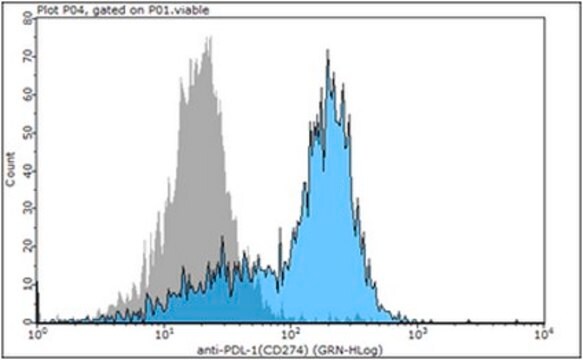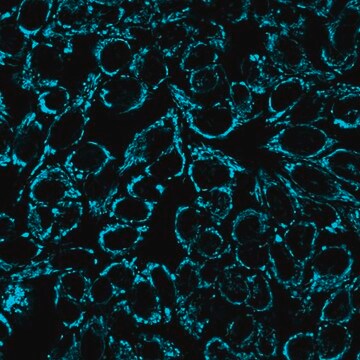APT142
MitoLight Mitochondrial Apoptosis Detection Kit
The MitoLight Apoptosis Detection Kit for flow cytometry utilizes a lipophilic cation, termed as MitoLight, as a mitochondrial activity marker.
Autenticatiper visualizzare i prezzi riservati alla tua organizzazione & contrattuali
About This Item
Codice UNSPSC:
12161503
eCl@ss:
32161000
NACRES:
NA.32
Prodotti consigliati
Livello qualitativo
Produttore/marchio commerciale
Chemicon®
MitoLight
tecniche
flow cytometry: suitable
Metodo di rivelazione
fluorometric
Condizioni di spedizione
dry ice
Descrizione generale
Disruption of the mitochondrial transmembrane potential is one of the earliest intracellular events that occur following induction of apoptosis. The MitoLight Apoptosis Detection Kit utilizes a lipophilic cation, termed as MitoLight, as a mitochondrial activity marker. MitoLight is a mitochondrial dye that stains mitochondria in living cells in a membrane potential-dependent fashion. The monomer is in equilibrium with so-called J-aggregates, which are favored at higher dye concentration or higher mitochondrial membrane potential.
MitoLight partitions differently in healthy cells than in apoptotic cells. Therefore, it has been possible to use a fluorescence ratioing technique to study mitochondrial membrane potentials. In healthy cells, the dye accumulates and aggregates in the mitochondria, giving off a bright red fluorescence (λem = 585-590 nm). In apoptotic cells with altered mitochondrial membrane potential, the dye in its monomeric form stays in the cytoplasm, fluorescing green (λem = 527-530 nm), providing a ready discrimination between apoptotic and nonapoptotic cells. The fluorescence can be observed by fluorescence microscopy using a band-pass filter (detects FITC and rhodamine) or analyzed by flow cytometry using FITC channel for green monomers (Ex/Em = 488/530) and PI channel for red aggregates (Ex/Em = 488/585).
For research use only; Not for use in diagnostic procedures
MitoLight partitions differently in healthy cells than in apoptotic cells. Therefore, it has been possible to use a fluorescence ratioing technique to study mitochondrial membrane potentials. In healthy cells, the dye accumulates and aggregates in the mitochondria, giving off a bright red fluorescence (λem = 585-590 nm). In apoptotic cells with altered mitochondrial membrane potential, the dye in its monomeric form stays in the cytoplasm, fluorescing green (λem = 527-530 nm), providing a ready discrimination between apoptotic and nonapoptotic cells. The fluorescence can be observed by fluorescence microscopy using a band-pass filter (detects FITC and rhodamine) or analyzed by flow cytometry using FITC channel for green monomers (Ex/Em = 488/530) and PI channel for red aggregates (Ex/Em = 488/585).
For research use only; Not for use in diagnostic procedures
Applicazioni
Research Category
Apoptosis & Cancer
Apoptosis & Cancer
Componenti
MitoLight (Part No. 71612): 25 μL in DMSO.
10X Incubation Buffer (Part No. 71614): 20 mL.
10X Incubation Buffer (Part No. 71614): 20 mL.
Stoccaggio e stabilità
Store kit materials at -20°C up to their expiration date. After thawing, unused kit components can be refrozen. For best results, aliquot the MitoLight reagent into separate vials to avoid repeated freeze/thaw cycles.
PROTECT REAGENTS FROM LIGHT.
PROTECT REAGENTS FROM LIGHT.
Note legali
CHEMICON is a registered trademark of Merck KGaA, Darmstadt, Germany
Esclusione di responsabilità
Unless otherwise stated in our catalog or other company documentation accompanying the product(s), our products are intended for research use only and are not to be used for any other purpose, which includes but is not limited to, unauthorized commercial uses, in vitro diagnostic uses, ex vivo or in vivo therapeutic uses or any type of consumption or application to humans or animals.
Codice della classe di stoccaggio
10 - Combustible liquids
Certificati d'analisi (COA)
Cerca il Certificati d'analisi (COA) digitando il numero di lotto/batch corrispondente. I numeri di lotto o di batch sono stampati sull'etichetta dei prodotti dopo la parola ‘Lotto’ o ‘Batch’.
Possiedi già questo prodotto?
I documenti relativi ai prodotti acquistati recentemente sono disponibili nell’Archivio dei documenti.
I clienti hanno visto anche
Kolaviron protects apoptotic cell death in PC12 cells exposed to Atrazine.
Abarikwu SO, Farombi EO, Kashyap MP, Pant AB.
Free Radical Research null
Mahendra Pratap Kashyap et al.
PloS one, 6(3), e17757-e17757 (2011-03-30)
Monocrotophos (MCP) is a widely used organophosphate (OP) pesticide. We studied apoptotic changes and their correlation with expression of selected cytochrome P450s (CYPs) in PC12 cells exposed to MCP. A significant induction in reactive oxygen species (ROS) and decrease in
Il team dei nostri ricercatori vanta grande esperienza in tutte le aree della ricerca quali Life Science, scienza dei materiali, sintesi chimica, cromatografia, discipline analitiche, ecc..
Contatta l'Assistenza Tecnica.









